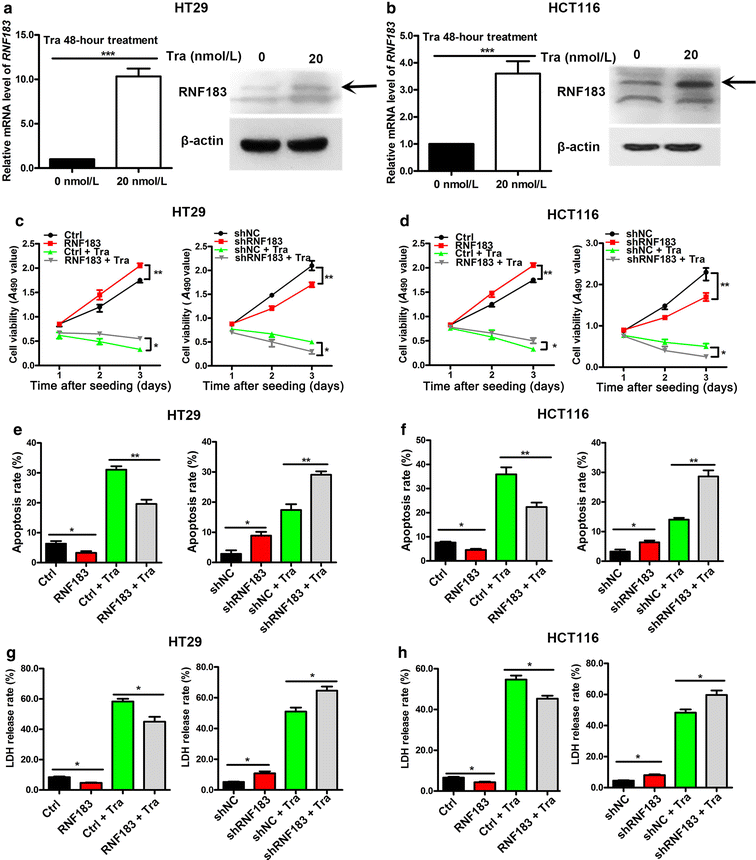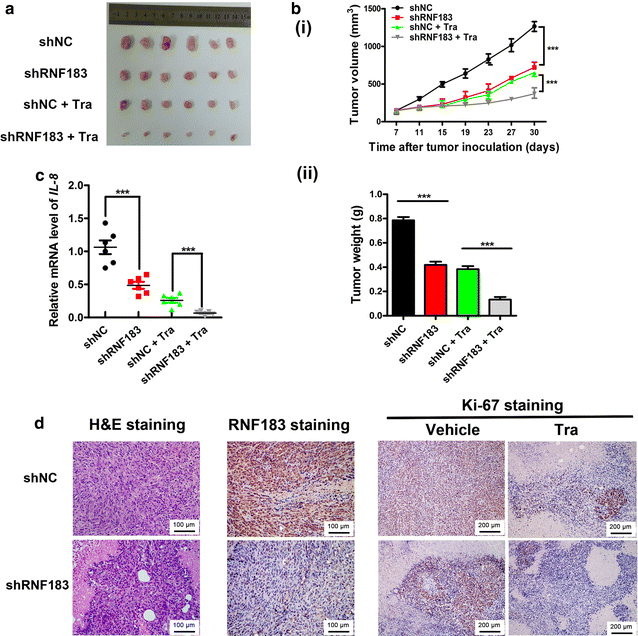Synthetic lethal short hairpin RNA screening reveals that ring finger protein 183 confers resistance to trametinib in colorectal cancer cells
- PMID: 28756770
- PMCID: PMC5535279
- DOI: 10.1186/s40880-017-0228-1
Synthetic lethal short hairpin RNA screening reveals that ring finger protein 183 confers resistance to trametinib in colorectal cancer cells
Abstract
Background: The mitogen-activated extracellular signal-regulated kinase 1/2 (MEK1/2) inhibitor trametinib has shown promising therapeutic effects on melanoma, but its efficacy on colorectal cancer (CRC) is limited. Synthetic lethality arises with a combination of two or more separate gene mutations that causes cell death, whereas individual mutations keep cells alive. This study aimed to identify the genes responsible for resistance to trametinib in CRC cells, using a synthetic lethal short hairpin RNA (shRNA) screening approach.
Methods: We infected HT29 cells with a pooled lentiviral shRNA library and applied next-generation sequencing to identify shRNAs with reduced abundance after 8-day treatment of 20 nmol/L trametinib. HCT116 and HT29 cells were used in validation studies. Stable ring finger protein 183 (RNF183)-overexpressing cell lines were generated by pcDNA4-myc/his-RNF183 transfection. Stable RNF183-knockdown cell lines were generated by infection of lentiviruses that express RNF183 shRNA, and small interference RNA (siRNA) was used to knock down RNF183 transiently. Quantitative real-time PCR was used to determine the mRNA expression. Western blotting, immunohistochemical analysis, and enzyme-linked immunosorbent assay (ELISA) were used to evaluate the protein abundance. MTT assay, colony formation assay, and subcutaneous xenograft tumor growth model were used to evaluate cell proliferation.
Results: In the primary screening, we found that the abundance of RNF183 shRNA was markedly reduced after treatment with trametinib. Trametinib induced the expression of RNF183, which conferred resistance to drug-induced cell growth repression and apoptotic and non-apoptotic cell deaths. Moreover, interleukin-8 (IL-8) was a downstream gene of RNF183 and was required for the function of RNF183 in facilitating cell growth. Additionally, elevated RNF183 expression partly reduced the inhibitory effect of trametinib on IL-8 expression. Finally, xenograft tumor model showed the synergism of RNF183 knockdown and trametinib in repressing the growth of CRC cells in vivo.
Conclusion: The RNF183-IL-8 axis is responsible for the resistance of CRC cells to the MEK1/2 inhibitor trametinib and may serve as a candidate target for combined therapy for CRC.
Keywords: Colorectal cancer; Mitogen-activated extracellular signal-regulated kinase 1/2; Ring finger protein 183; Synthetic lethal; Trametinib.
Figures




Similar articles
-
RNF183 promotes proliferation and metastasis of colorectal cancer cells via activation of NF-κB-IL-8 axis.Cell Death Dis. 2017 Aug 10;8(8):e2994. doi: 10.1038/cddis.2017.400. Cell Death Dis. 2017. PMID: 28796265 Free PMC article.
-
Low‑dose trametinib and Bcl‑xL antagonist have a specific antitumor effect in KRAS‑mutated colorectal cancer cells.Int J Oncol. 2020 Nov;57(5):1179-1191. doi: 10.3892/ijo.2020.5117. Epub 2020 Sep 2. Int J Oncol. 2020. PMID: 32901840
-
Silencing GOLPH3 gene expression reverses resistance to cisplatin in HT29 colon cancer cells via multiple signaling pathways.Int J Oncol. 2018 Sep;53(3):1183-1192. doi: 10.3892/ijo.2018.4471. Epub 2018 Jul 5. Int J Oncol. 2018. PMID: 30015866
-
Specific small interfering RNAs (siRNAs) for targeting the metastasis, immune responses, and drug resistance of colorectal cancer cells (CRC).Int Immunopharmacol. 2024 Oct 25;140:112730. doi: 10.1016/j.intimp.2024.112730. Epub 2024 Jul 30. Int Immunopharmacol. 2024. PMID: 39083927 Review.
-
Recent developments in targeting genes and pathways by RNAi-based approaches in colorectal cancer.Med Res Rev. 2021 Jan;41(1):395-434. doi: 10.1002/med.21735. Epub 2020 Sep 29. Med Res Rev. 2021. PMID: 32990372 Review.
Cited by
-
RNAi Screening Identifies that TEX10 Promotes the Proliferation of Colorectal Cancer Cells by Increasing NF-κB Activation.Adv Sci (Weinh). 2020 Jul 7;7(17):2000593. doi: 10.1002/advs.202000593. eCollection 2020 Sep. Adv Sci (Weinh). 2020. PMID: 32995120 Free PMC article.
-
[Protein ubiquitination on the regulation of inflammatory bowel disease].Zhejiang Da Xue Xue Bao Yi Xue Ban. 2018 Jan 25;47(1):82-88. doi: 10.3785/j.issn.1008-9292.2018.02.12. Zhejiang Da Xue Xue Bao Yi Xue Ban. 2018. PMID: 30146816 Free PMC article. Review. Chinese.
-
Knockdown of RNF183 suppressed proliferation of lung adenocarcinoma cells via inactivating the STAT3 signaling pathway.Cell Cycle. 2022 May;21(9):948-960. doi: 10.1080/15384101.2022.2035617. Epub 2022 Feb 1. Cell Cycle. 2022. Retraction in: Cell Cycle. 2024 Sep-Oct;23(17-20):i. doi: 10.1080/15384101.2024.2370723. PMID: 35104174 Free PMC article. Retracted.
-
Comprehensive Analysis of E3 Ubiquitin Ligases Reveals Ring Finger Protein 223 as a Novel Oncogene Activated by KLF4 in Pancreatic Cancer.Front Cell Dev Biol. 2021 Oct 14;9:738709. doi: 10.3389/fcell.2021.738709. eCollection 2021. Front Cell Dev Biol. 2021. PMID: 34722520 Free PMC article.
-
The Role of Tissue-Specific Ubiquitin Ligases, RNF183, RNF186, RNF182 and RNF152, in Disease and Biological Function.Int J Mol Sci. 2020 May 30;21(11):3921. doi: 10.3390/ijms21113921. Int J Mol Sci. 2020. PMID: 32486221 Free PMC article. Review.
References
MeSH terms
Substances
LinkOut - more resources
Full Text Sources
Other Literature Sources
Medical
Molecular Biology Databases
Miscellaneous

